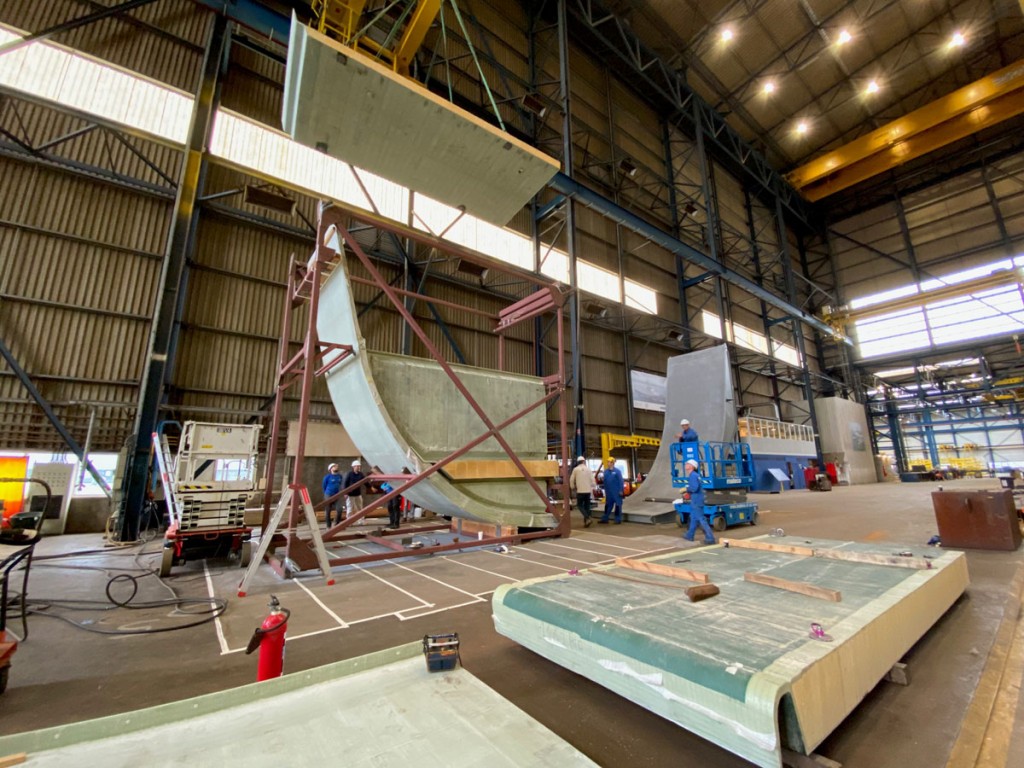On 18th July, the Realisation and Demonstration of Advanced Material Solutions for Sustainable and Efficient Ships (RAMSSES) project reached a key milestone. On that date, at Damen Schelde Naval Shipbuilding’s (DSNS) location in Vlissingen-East, the Netherlands, the project’s partners unveiled the recently assembled full scale composite ship’s hull section they have been developing these past three years. This, entitled Custom Made Hull for Offshore Vessel, represents one of thirteen demonstrators that make up the RAMSSES project. The project can now go forward with a series of tests that, it is anticipated, will demonstrate the viability of large composite ships as a sustainable shipping solution.
There are numerous benefits to composite shipbuilding – chief amongst which is the contribution composites make towards greater maritime efficiency and sustainability. A composite vessel like the one the RAMSSES partners are working towards would weigh up to 40% less than a steel equivalent. The results of this are a considerable reduction in both fuel consumption and emissions. In fact, a composite vessel can offer a reduction in global warming potential, aerosol formation potential, eutrophication potential, acidification potential and fuel consumption by up to 25%.

This work section of the project is led by DSNS and Damen Shipyards Gorinchem (DSGo), which has developed the baseline design. Engineering has been performed by Airborne UK and InfraCore Company, who have brought their expertise in composites to the project. Evonik has developed the resin to infuse the composites. Following assembly, TNO will now perform full scale tests for validation of design, quality management and structural performance. Classification Society Bureau Veritas has provided consultancy and advice that will lead to a smart track to approval.
The approval process has been developed in close cooperation with Research Institutes of Sweden (RISE), Netherlands Maritime Technology Foundation and Bureau Veritas. A Hazld (hazard identification) test has already been performed by RISE and Bureau Veritas to address all fire risks. The fire performance criteria defined will be tested and validated at the facilities of RISE.
The project work has also pioneered the capability to infuse thick laminates up to six metres in height. Furthermore, performing the assembly at DSNS’ location has demonstrated the possibility to undertake composite construction at a steel yard.
“The work we are doing here is important for the future of shipping. Sustainability is a major focus in industry right now and shipbuilding is no exception,” says Marcel Elenbaas, senior engineer at Research & Technology Support DSNS. “The use of composites for larger ships has significant consequences for the entire design of the ship. If it is lighter, a vessel uses less fuel and produces lower emissions. The vessel also requires smaller engines, which means more space for additional systems, making for a more versatile platform. And of course, composites require considerably less maintenance than a steel vessel. With RAMSSES we have the opportunity to demonstrate the effectiveness and viability of large-scale composite shipbuilding.”
The RAMSSES project has received funding from the European Union’s Horizon 2020 research and innovation programme under grant agreement No 723246. Other demonstrators in the RAMSSES project include innovative components and modular lightweight systems, maritime equipment, the application of high performance steels in load carrying hull structures, the integration of composite materials in various structures, as well as solutions for global repair.









